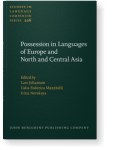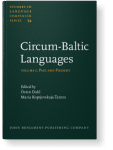Éva Ágnes Csató
List of John Benjamins publications for which Éva Ágnes Csató plays a role.
Articles
2019 On Turkish non-canonical possessives Possession in Languages of Europe and North and Central Asia, Johanson, Lars, Lidia Federica Mazzitelli and Irina Nevskaya (eds.), pp. 85–102 | Chapter
Turkic canonical possessive noun phrases consist of the possessor marked with the genitive, and the possessee with a possessive suffix. This study deals with Turkic non-canonical constructions, where a genitive marker attaches to the possessor, but the possessee remains unmarked. It is argued that… read more
2014 Chapter 6. Perceived formal and functional equivalence: The Hungarian ik-conjugation Paradigm Change: In the Transeurasian languages and beyond, Robbeets, Martine and Walter Bisang (eds.), pp. 129–140 | Chapter
Hungarian prefers indirect insertion of copied verbal stems. The few counterexamples of directly inserted verbal stems indicate a high degree of intimacy due to intensive contact or relatedness. András Róna-Tas and Árpád Berta’s work West Old Turkic published in 2011 gives a list of over thirty… read more
2014 Areal features of copula sentences in Karaim as spoken in Lithuania On Diversity and Complexity of Languages Spoken in Europe and North and Central Asia, Suihkonen, Pirkko and Lindsay J. Whaley (eds.), pp. 203–220 | Article
The paper deals with copula clauses in Karaim, a highly endangered Kipchak Turkic language spoken in Lithuania. Karaim has been dominated by the non-Turkic (Baltic and Slavic) languages of the area. Though Karaim has acquired many properties not typical of Turkic it has preserved its Turkic… read more
2013 Chapter 11. Growing apart in shared grammaticalization Shared Grammaticalization: With special focus on the Transeurasian languages, Robbeets, Martine and Hubert Cuyckens (eds.), pp. 251–258 | Chapter
This article deals with shared grammaticalization of indirectives in Turkic. Indirectivity, a genuine Turkic grammatical category, is expressed by different morphological markers across the Turkic varieties; the paths of grammaticalization are, however, isomorphic. It is argued that intensive… read more
2001 Syntactic code-copying in Karaim Circum-Baltic Languages: Volume 1: Past and Present, Dahl, Östen and Maria Koptjevskaja-Tamm (eds.), pp. cclxxi–cclxxxiii | Chapter




